Abstract
The existence of two distinct antigenic sites at the surface of simian virus 40 (SV40)-transformed H-2b cells has been previously demonstrated (A. E. Campbell, L. F. Foley, and S. S. Tevethia, J. Immunol. 130:490-492, 1983) by using two independently isolated SV40-specific cytotoxic T-lymphocyte (CTL) clones, K11 and K19. We identified amino acids in the amino-terminal half of SV40 T antigen that are essential for the recognition of antigenic sites by these CTL clones by using H-2b cells transformed by mutants that produce T antigen truncated from the amino-terminal or carboxy-terminal end or carrying overlapping internal deletions in the amino-terminal regions of SV40 T antigen. The results show that CTL clone K11 failed to recognize and lyse target cells missing SV40 T-antigen amino acids 189 to 211, whereas CTL clone K19 lysed these cells. The cell lines missing SV40 T-antigen amino acids 220 to 223 and 220 to 228 were not lysed by CTL clone K19 but were susceptible to lysis by CTL clone K11. Two other cell lines missing amino acids 189 to 223 and 189 to 228 of SV40 T antigen were not lysed by either of the CTL clones but were lysed by SV40-specific bulk-culture CTL if sufficient amounts of relevant restriction elements were expressed at the cell surface. The SV40 T-antigen amino acids critical for the recognition of an antigenic site by CTL clone K11 were identified to be 193 to 211; 220 to 223 were identified as critical for recognition by CTL clone K19. The deletion of these amino acids from the T antigen resulted in the loss of antigenic sites specific for CTL clones K11 and K19.
Full text
PDF
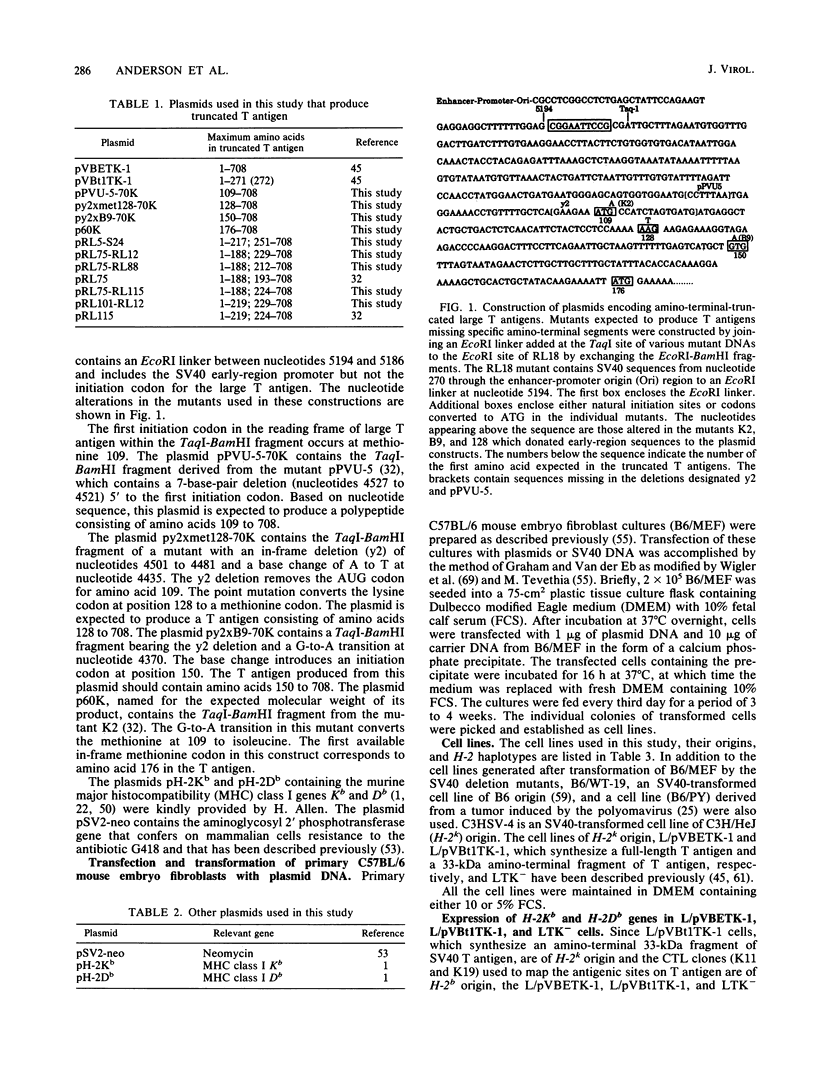
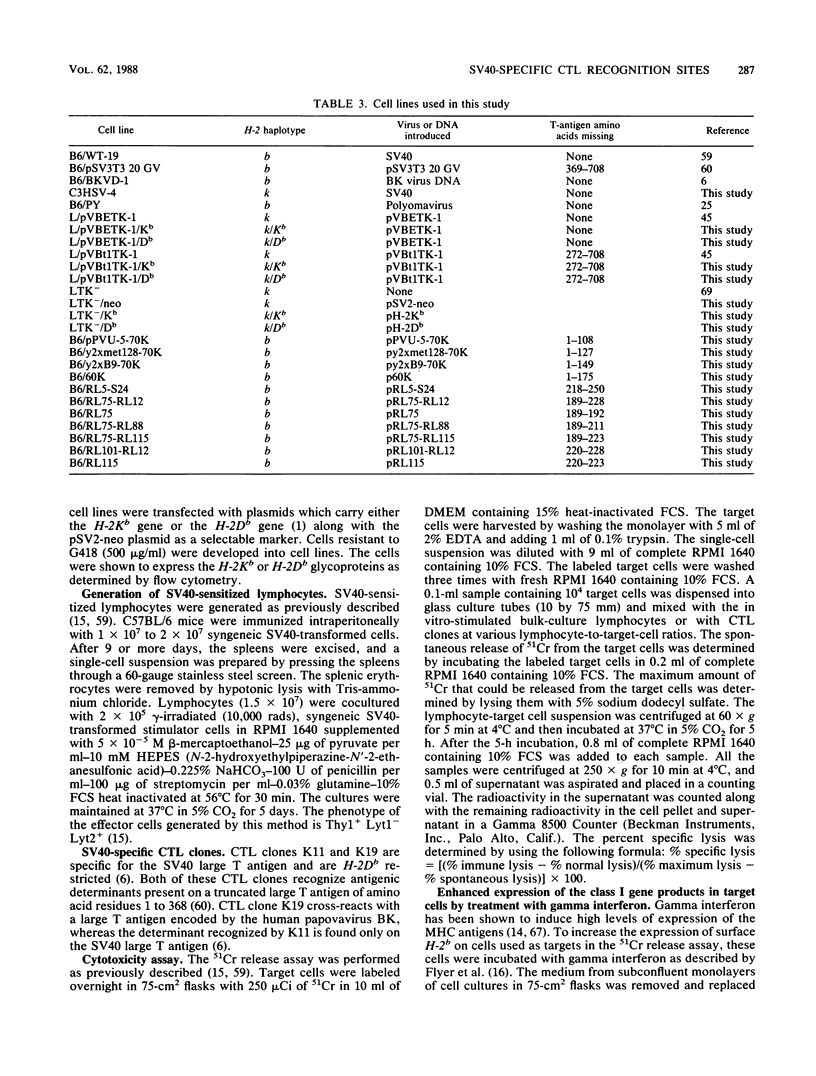
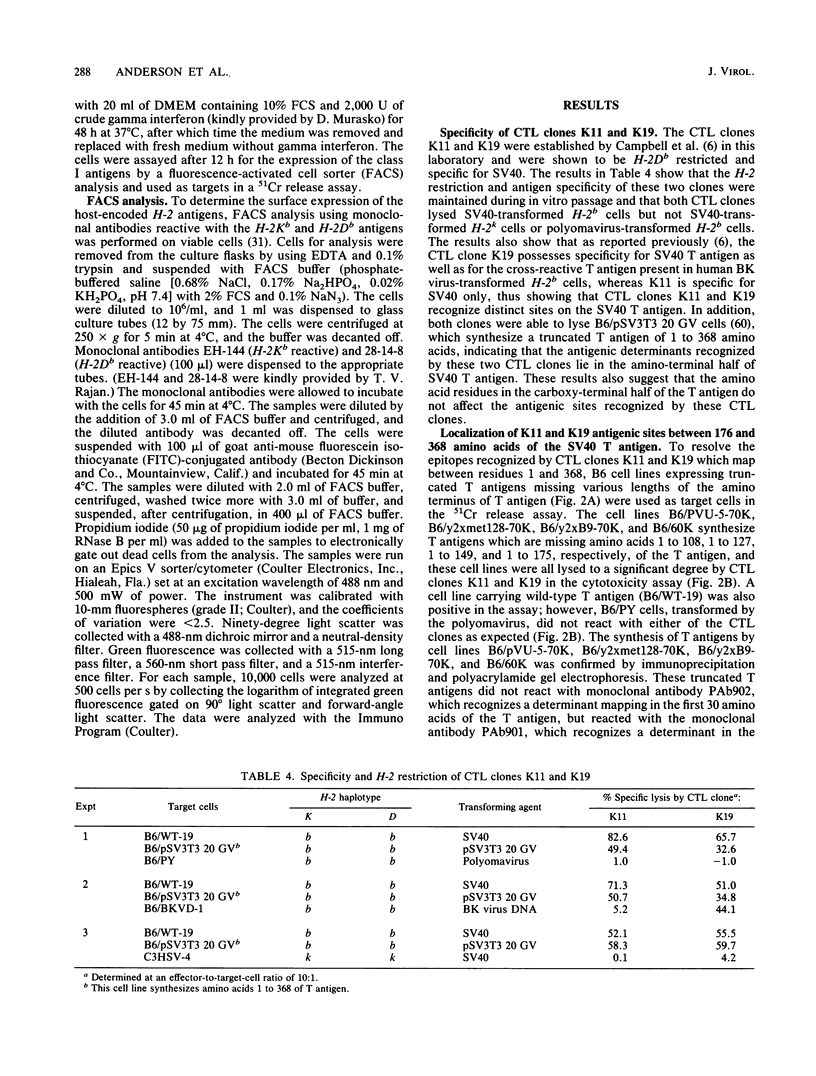
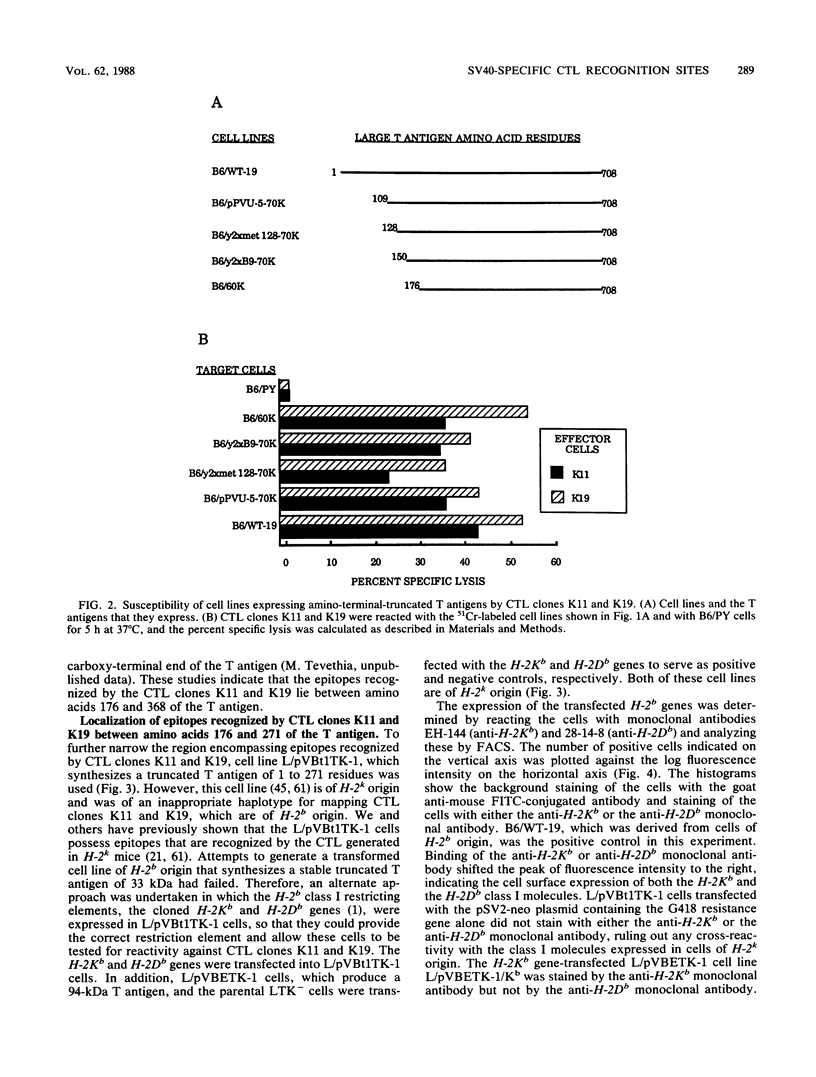
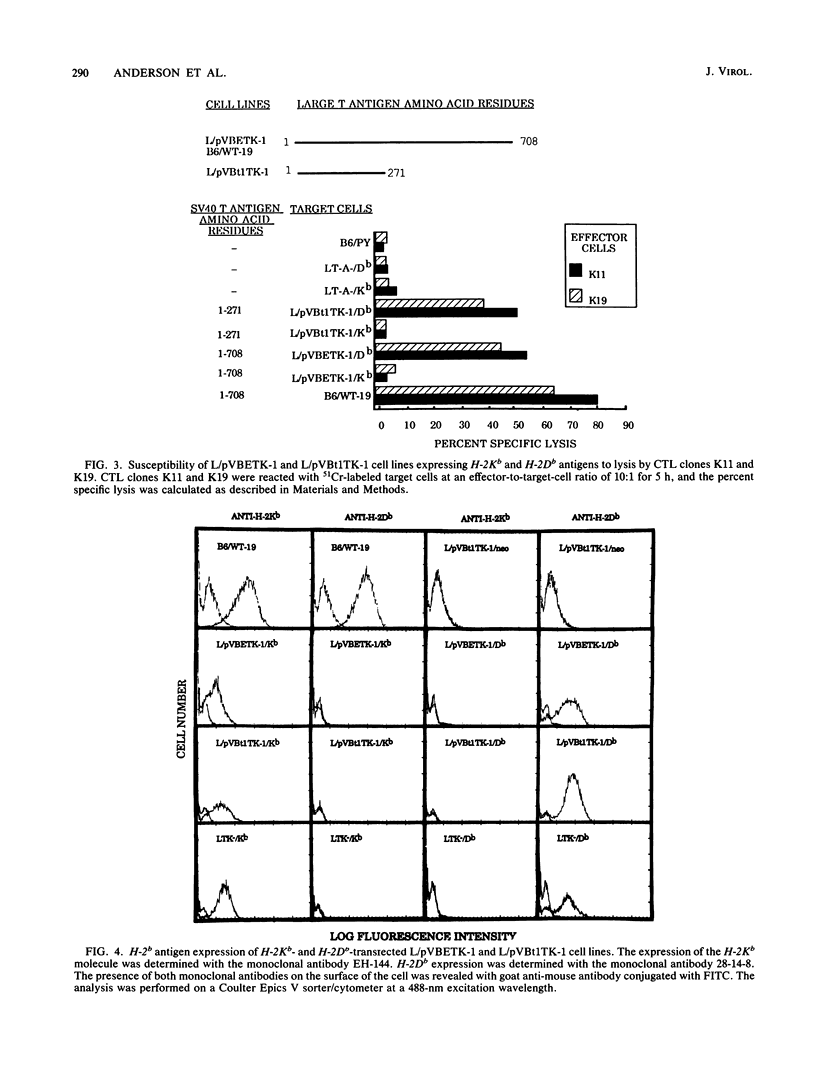
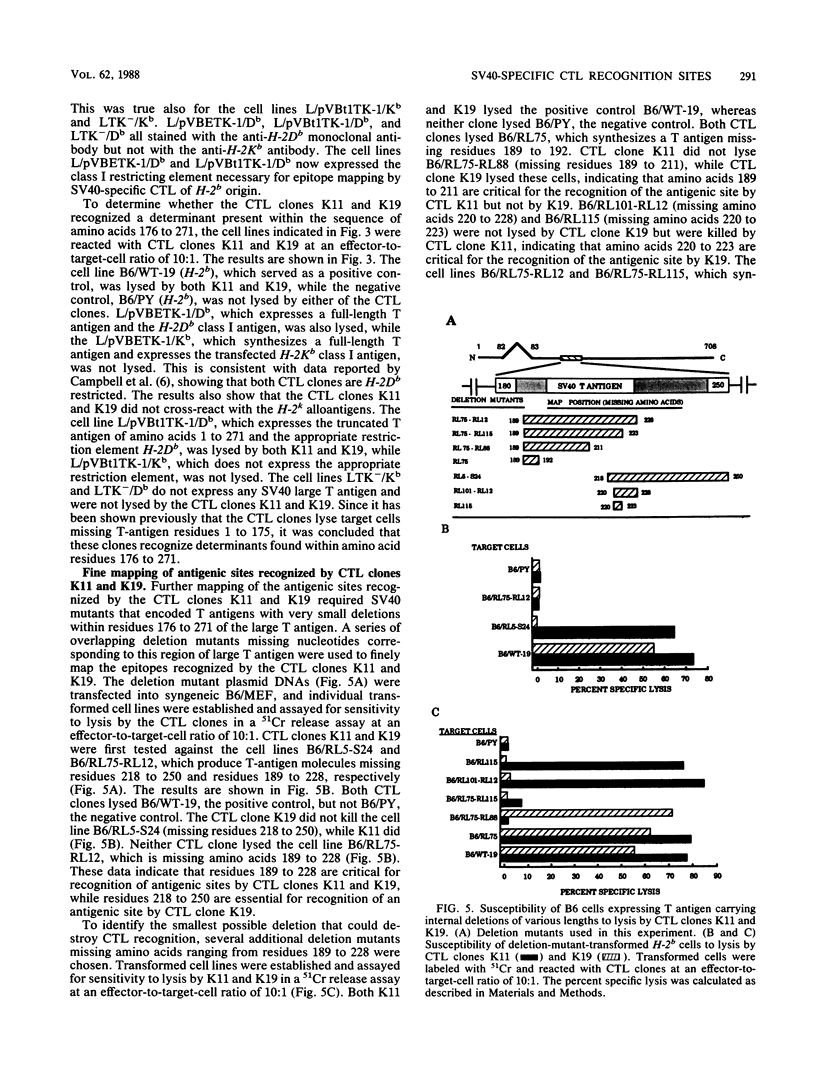
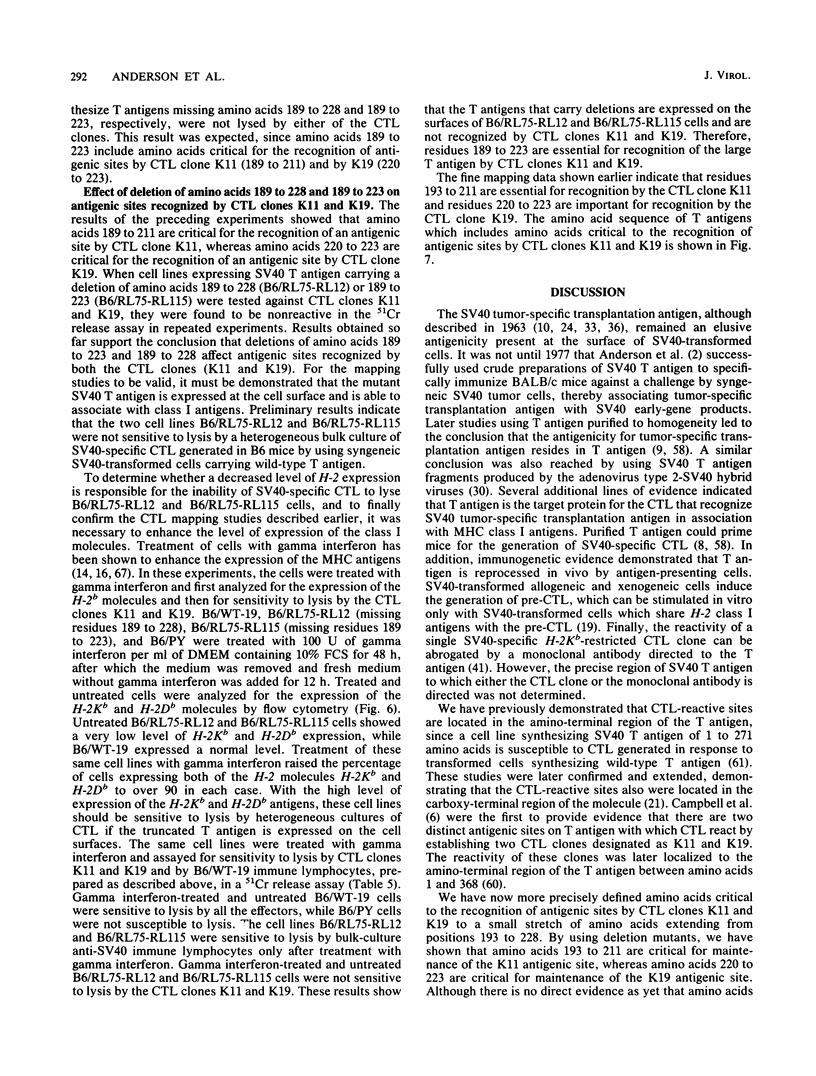
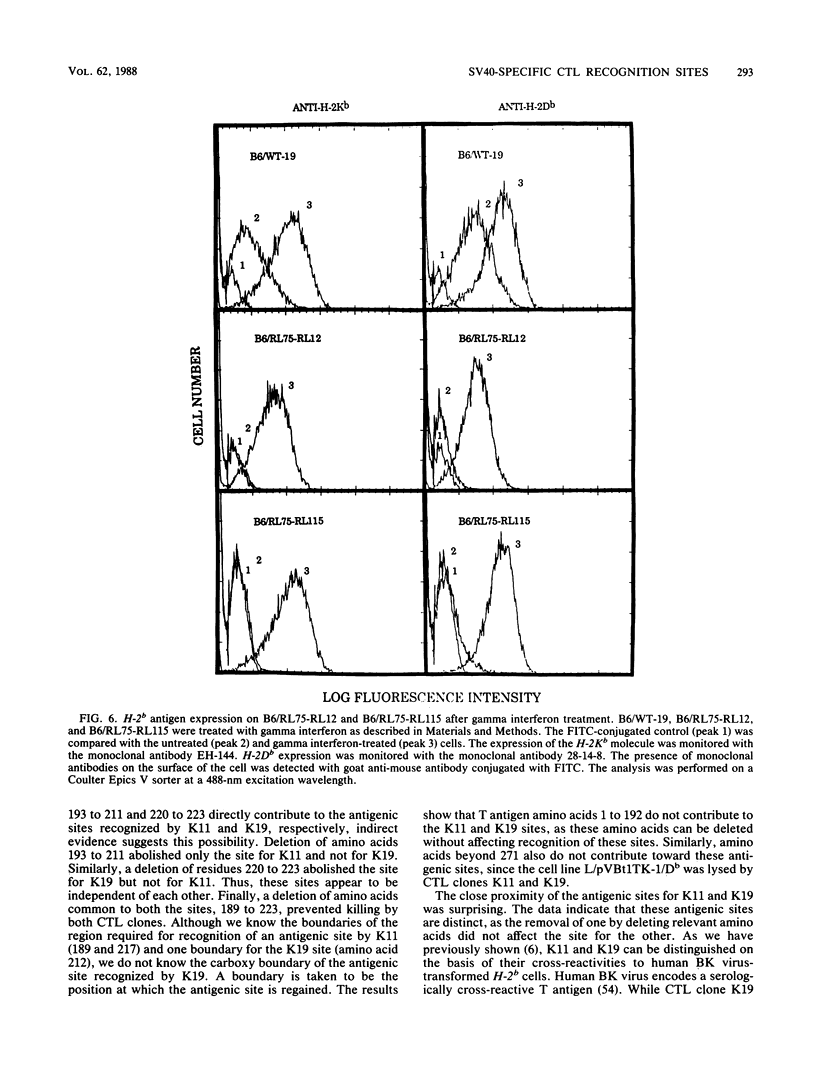
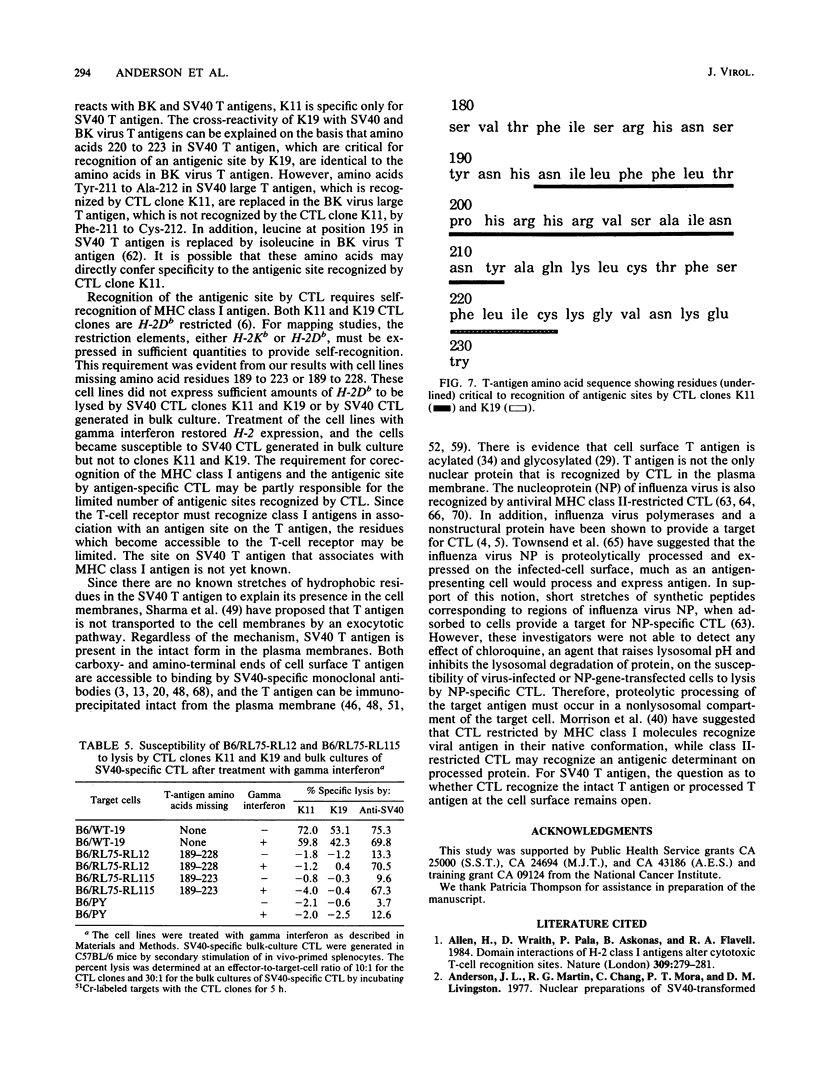
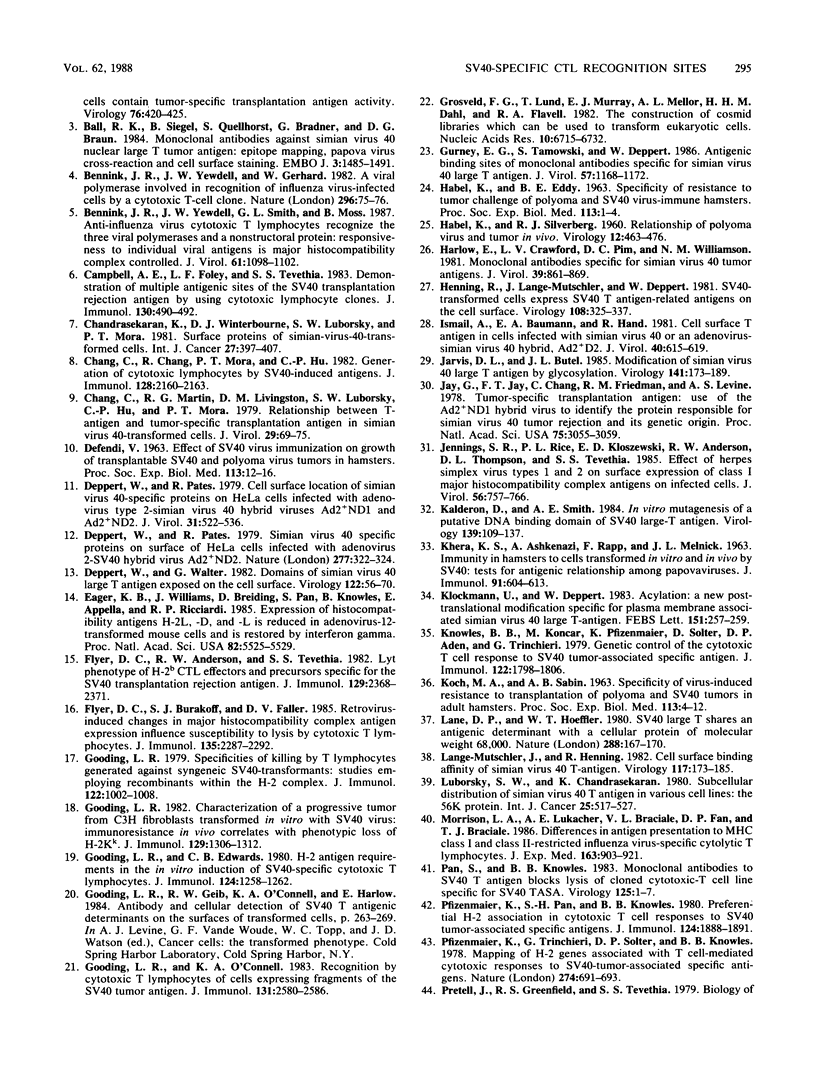
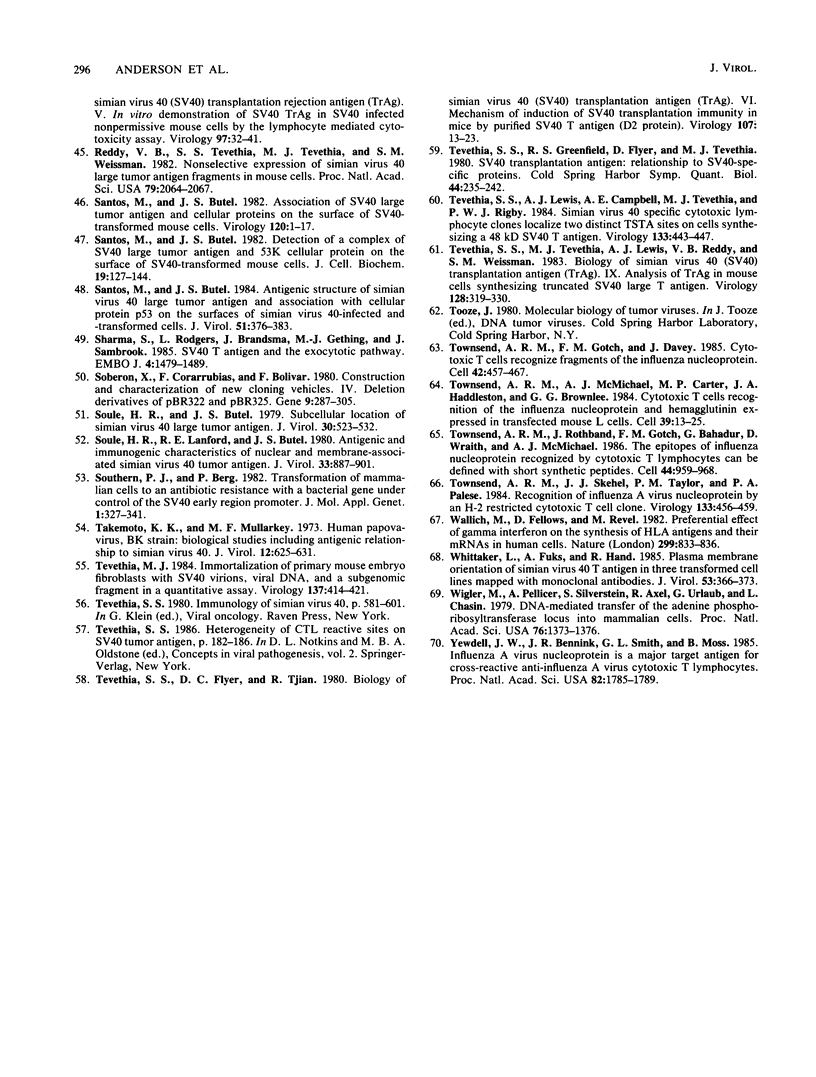
Selected References
These references are in PubMed. This may not be the complete list of references from this article.
- Allen H., Wraith D., Pala P., Askonas B., Flavell R. A. Domain interactions of H-2 class I antigens alter cytotoxic T-cell recognition sites. Nature. 1984 May 17;309(5965):279–281. doi: 10.1038/309279a0. [DOI] [PubMed] [Google Scholar]
- Anderson J. L., Martin R. G., Chang C., Mora P. T., Livingston D. M. Nuclear preparations of SV40-transformed cells contain tumor-specific transplantation antigen activity. Virology. 1977 Jan;76(1):420–425. doi: 10.1016/0042-6822(77)90314-2. [DOI] [PubMed] [Google Scholar]
- Ball R. K., Siegl B., Quellhorst S., Brandner G., Braun D. G. Monoclonal antibodies against simian virus 40 nuclear large T tumour antigen: epitope mapping, papova virus cross-reaction and cell surface staining. EMBO J. 1984 Jul;3(7):1485–1491. doi: 10.1002/j.1460-2075.1984.tb02000.x. [DOI] [PMC free article] [PubMed] [Google Scholar]
- Bennink J. R., Yewdell J. W., Gerhard W. A viral polymerase involved in recognition of influenza virus-infected cells by a cytotoxic T-cell clone. Nature. 1982 Mar 4;296(5852):75–76. doi: 10.1038/296075a0. [DOI] [PubMed] [Google Scholar]
- Bennink J. R., Yewdell J. W., Smith G. L., Moss B. Anti-influenza virus cytotoxic T lymphocytes recognize the three viral polymerases and a nonstructural protein: responsiveness to individual viral antigens is major histocompatibility complex controlled. J Virol. 1987 Apr;61(4):1098–1102. doi: 10.1128/jvi.61.4.1098-1102.1987. [DOI] [PMC free article] [PubMed] [Google Scholar]
- Campbell A. E., Foley F. L., Tevethia S. S. Demonstration of multiple antigenic sites of the SV40 transplantation rejection antigen by using cytotoxic T lymphocyte clones. J Immunol. 1983 Jan;130(1):490–492. [PubMed] [Google Scholar]
- Chandrasekaran K., Winterbourne D. J., Luborsky S. W., Mora P. T. Surface proteins of simian-virus-40-transformed cells. Int J Cancer. 1981 Mar 15;27(3):397–407. doi: 10.1002/ijc.2910270320. [DOI] [PubMed] [Google Scholar]
- Chang C., Chang R., Mora P. T., Hu C. P. Generation of cytotoxic lymphocytes by SV40-induced antigens. J Immunol. 1982 May;128(5):2160–2163. [PubMed] [Google Scholar]
- Chang C., Martin R. G., Livingston D. M., Luborsky S. W., Hu C. P., Mora P. T. Relationship between T-antigen and tumor-specific transplantation antigen in simian virus 40-transformed cells. J Virol. 1979 Jan;29(1):69–75. doi: 10.1128/jvi.29.1.69-75.1979. [DOI] [PMC free article] [PubMed] [Google Scholar]
- DEFENDI V. Effect of SV 40 virus immunization on growth of transplantable SV 40 and polyoma virus tumors in hamsters. Proc Soc Exp Biol Med. 1963 May;113:12–16. doi: 10.3181/00379727-113-28261. [DOI] [PubMed] [Google Scholar]
- Deppert W., Pates R. Cell surface location of simian virus 40-specific proteins on HeLa cells infected with adenovirus type 2-simian virus 40 hybrid viruses Ad2+ND1 and Ad2+ND2. J Virol. 1979 Aug;31(2):522–536. doi: 10.1128/jvi.31.2.522-536.1979. [DOI] [PMC free article] [PubMed] [Google Scholar]
- Deppert W., Pates R. Simian virus 40 specific proteins on surface of HeLa cells infected with adenovirus 2--SV40 hybrid virus Ad2+ND2. Nature. 1979 Jan 25;277(5694):322–324. doi: 10.1038/277322a0. [DOI] [PubMed] [Google Scholar]
- Deppert W., Walter G. Domains of simian virus 40 large T-antigen exposed on the cell surface. Virology. 1982 Oct 15;122(1):56–70. doi: 10.1016/0042-6822(82)90377-4. [DOI] [PubMed] [Google Scholar]
- Eager K. B., Williams J., Breiding D., Pan S., Knowles B., Appella E., Ricciardi R. P. Expression of histocompatibility antigens H-2K, -D, and -L is reduced in adenovirus-12-transformed mouse cells and is restored by interferon gamma. Proc Natl Acad Sci U S A. 1985 Aug;82(16):5525–5529. doi: 10.1073/pnas.82.16.5525. [DOI] [PMC free article] [PubMed] [Google Scholar]
- Flyer D. C., Anderson R. W., Tevethia S. S. Lyt phenotype of H-2b CTL effectors and precursors specific for the SV40 transplantation rejection antigen. J Immunol. 1982 Dec;129(6):2368–2371. [PubMed] [Google Scholar]
- Flyer D. C., Burakoff S. J., Faller D. V. Retrovirus-induced changes in major histocompatibility complex antigen expression influence susceptibility to lysis by cytotoxic T lymphocytes. J Immunol. 1985 Oct;135(4):2287–2292. [PubMed] [Google Scholar]
- Gooding L. R. Characterization of a progressive tumor from C3H fibroblasts transformed in vitro with SV40 virus. Immunoresistance in vivo correlates with phenotypic loss of H-2Kk. J Immunol. 1982 Sep;129(3):1306–1312. [PubMed] [Google Scholar]
- Gooding L. R., Edwards C. B. H-2 antigen requirements in the in vitro induction of SV40-specific cytotoxic T lymphocytes. J Immunol. 1980 Mar;124(3):1258–1262. [PubMed] [Google Scholar]
- Gooding L. R., O'Connell K. A. Recognition by cytotoxic T lymphocytes of cells expressing fragments of the SV40 tumor antigen. J Immunol. 1983 Nov;131(5):2580–2586. [PubMed] [Google Scholar]
- Gooding L. R. Specificities of killing by T lymphocytes generated against syngeneic SV40 transformants: studies employing recombinants within the H-2 complex. J Immunol. 1979 Mar;122(3):1002–1008. [PubMed] [Google Scholar]
- Grosveld F. G., Lund T., Murray E. J., Mellor A. L., Dahl H. H., Flavell R. A. The construction of cosmid libraries which can be used to transform eukaryotic cells. Nucleic Acids Res. 1982 Nov 11;10(21):6715–6732. doi: 10.1093/nar/10.21.6715. [DOI] [PMC free article] [PubMed] [Google Scholar]
- Gurney E. G., Tamowski S., Deppert W. Antigenic binding sites of monoclonal antibodies specific for simian virus 40 large T antigen. J Virol. 1986 Mar;57(3):1168–1172. doi: 10.1128/jvi.57.3.1168-1172.1986. [DOI] [PMC free article] [PubMed] [Google Scholar]
- HABEL K., SILVERBERG R. J. Relationship of polyoma virus and tumor in vivo. Virology. 1960 Nov;12:463–476. doi: 10.1016/0042-6822(60)90167-7. [DOI] [PubMed] [Google Scholar]
- Harlow E., Crawford L. V., Pim D. C., Williamson N. M. Monoclonal antibodies specific for simian virus 40 tumor antigens. J Virol. 1981 Sep;39(3):861–869. doi: 10.1128/jvi.39.3.861-869.1981. [DOI] [PMC free article] [PubMed] [Google Scholar]
- Henning R., Lange-Mutschler J., Deppert W. SV40-transformed cells express SV40 T antigen-related antigens on the cell surface. Virology. 1981 Jan 30;108(2):325–337. doi: 10.1016/0042-6822(81)90441-4. [DOI] [PubMed] [Google Scholar]
- Ismail A., Baumann E. A., Hand R. Cell surface T antigen in cells infected with simian virus 40 or an adenovirus-simian virus 40 hybrid, Ad2+D2. J Virol. 1981 Nov;40(2):615–619. doi: 10.1128/jvi.40.2.615-619.1981. [DOI] [PMC free article] [PubMed] [Google Scholar]
- Jarvis D. L., Butel J. S. Modification of simian virus 40 large tumor antigen by glycosylation. Virology. 1985 Mar;141(2):173–189. doi: 10.1016/0042-6822(85)90250-8. [DOI] [PMC free article] [PubMed] [Google Scholar]
- Jay G., Jay F. T., Chang C., Friedman R. M., Levine A. S. Tumor-specific transplantation antigen: use of the Ad2+ND1 hybrid virus to identify the protein responsible for simian virus 40 tumor rejection and its genetic origin. Proc Natl Acad Sci U S A. 1978 Jul;75(7):3055–3059. doi: 10.1073/pnas.75.7.3055. [DOI] [PMC free article] [PubMed] [Google Scholar]
- Jennings S. R., Rice P. L., Kloszewski E. D., Anderson R. W., Thompson D. L., Tevethia S. S. Effect of herpes simplex virus types 1 and 2 on surface expression of class I major histocompatibility complex antigens on infected cells. J Virol. 1985 Dec;56(3):757–766. doi: 10.1128/jvi.56.3.757-766.1985. [DOI] [PMC free article] [PubMed] [Google Scholar]
- KHERA K. S., ASHKENAZI A., RAPP F., MELNICK J. L. IMMUNITY IN HAMSTERS TO CELLS TRANSFORMED IN VITRO AND IN VIVO BY SV40. TESTS FOR ANTIGENIC RELATIONSHIP AMONG THE PAPOVAVIRUSES. J Immunol. 1963 Nov;91:604–613. [PubMed] [Google Scholar]
- KOCH M. A., SABIN A. B. Specificity of virus-induced resistance to transplantation of polyoma and SV 40 tumors in adult hamsters. Proc Soc Exp Biol Med. 1963 May;113:4–12. doi: 10.3181/00379727-113-28260. [DOI] [PubMed] [Google Scholar]
- Kalderon D., Smith A. E. In vitro mutagenesis of a putative DNA binding domain of SV40 large-T. Virology. 1984 Nov;139(1):109–137. doi: 10.1016/0042-6822(84)90334-9. [DOI] [PubMed] [Google Scholar]
- Klockmann U., Deppert W. Acylation: a new post-translational modification specific for plasma membrane-associated simian virus 40 large T-antigen. FEBS Lett. 1983 Jan 24;151(2):257–259. doi: 10.1016/0014-5793(83)80081-7. [DOI] [PubMed] [Google Scholar]
- Knowles B. B., Koncar M., Pfizenmaier K., Solter D., Aden D. P., Trinchieri G. Genetic control of the cytotoxic T cell response to SV40 tumor-associated specific antigen. J Immunol. 1979 May;122(5):1798–1806. [PubMed] [Google Scholar]
- Lane D. P., Hoeffler W. K. SV40 large T shares an antigenic determinant with a cellular protein of molecular weight 68,000. Nature. 1980 Nov 13;288(5787):167–170. doi: 10.1038/288167a0. [DOI] [PubMed] [Google Scholar]
- Lange-Mutschler J., Henning R. Cell surface binding affinity of simian virus and 40 T-antigen. Virology. 1982 Feb;117(1):173–185. doi: 10.1016/0042-6822(82)90517-7. [DOI] [PubMed] [Google Scholar]
- Luborsky S. W., Chandrasekaran K. Subcellular distribution of simian virus 40 T antigen species in various cell lines: the 56K protein. Int J Cancer. 1980 Apr 15;25(4):517–527. doi: 10.1002/ijc.2910250414. [DOI] [PubMed] [Google Scholar]
- Morrison L. A., Lukacher A. E., Braciale V. L., Fan D. P., Braciale T. J. Differences in antigen presentation to MHC class I-and class II-restricted influenza virus-specific cytolytic T lymphocyte clones. J Exp Med. 1986 Apr 1;163(4):903–921. doi: 10.1084/jem.163.4.903. [DOI] [PMC free article] [PubMed] [Google Scholar]
- Pan S., Knowles B. B. Monoclonal antibody to SV40 T-antigen blocks lysis of cloned cytotoxic T-cell line specific for SV40 TASA. Virology. 1983 Feb;125(1):1–7. doi: 10.1016/0042-6822(83)90058-2. [DOI] [PubMed] [Google Scholar]
- Pfizenmaier K., Pan S. H., Knowles B. B. Preferential H-2 association in cytotoxic T cell responses to SV40 tumor-associated specific antigens. J Immunol. 1980 Apr;124(4):1888–1891. [PubMed] [Google Scholar]
- Pfizenmaier K., Trinchieri G., Solter D., Knowles B. B. Mapping of H-2 genes associated with T cell-mediated cytotoxic responses to SV40-tumour-associated specific antigens. Nature. 1978 Aug 17;274(5672):691–693. doi: 10.1038/274691a0. [DOI] [PubMed] [Google Scholar]
- Reddy V. B., Tevethia S. S., Tevethia M. J., Weissman S. M. Nonselective expression of simian virus 40 large tumor antigen fragments in mouse cells. Proc Natl Acad Sci U S A. 1982 Mar;79(6):2064–2067. doi: 10.1073/pnas.79.6.2064. [DOI] [PMC free article] [PubMed] [Google Scholar]
- Santos M., Butel J. S. Antigenic structure of simian virus 40 large tumor antigen and association with cellular protein p53 on the surfaces of simian virus 40-infected and -transformed cells. J Virol. 1984 Aug;51(2):376–383. doi: 10.1128/jvi.51.2.376-383.1984. [DOI] [PMC free article] [PubMed] [Google Scholar]
- Santos M., Butel J. S. Association of SV40 large tumor antigen and cellular proteins on the surface of SV40-transformed mouse cells. Virology. 1982 Jul 15;120(1):1–17. doi: 10.1016/0042-6822(82)90002-2. [DOI] [PubMed] [Google Scholar]
- Santos M., Butel J. S. Detection of a complex of SV40 large tumor antigen and 53K cellular protein on the surface of SV40-transformed mouse cells. J Cell Biochem. 1982;19(2):127–144. doi: 10.1002/jcb.240190204. [DOI] [PubMed] [Google Scholar]
- Sharma S., Rodgers L., Brandsma J., Gething M. J., Sambrook J. SV40 T antigen and the exocytotic pathway. EMBO J. 1985 Jun;4(6):1479–1489. doi: 10.1002/j.1460-2075.1985.tb03806.x. [DOI] [PMC free article] [PubMed] [Google Scholar]
- Soberon X., Covarrubias L., Bolivar F. Construction and characterization of new cloning vehicles. IV. Deletion derivatives of pBR322 and pBR325. Gene. 1980 May;9(3-4):287–305. doi: 10.1016/0378-1119(90)90328-o. [DOI] [PubMed] [Google Scholar]
- Soule H. R., Butel J. S. Subcellular Localization of simian virus 40 large tumor antigen. J Virol. 1979 May;30(2):523–532. doi: 10.1128/jvi.30.2.523-532.1979. [DOI] [PMC free article] [PubMed] [Google Scholar]
- Soule H. R., Lanford R. E., Butel J. S. Antigenic and immunogenic characteristics of nuclear and membrane-associated simian virus 40 tumor antigen. J Virol. 1980 Feb;33(2):887–901. doi: 10.1128/jvi.33.2.887-901.1980. [DOI] [PMC free article] [PubMed] [Google Scholar]
- Southern P. J., Berg P. Transformation of mammalian cells to antibiotic resistance with a bacterial gene under control of the SV40 early region promoter. J Mol Appl Genet. 1982;1(4):327–341. [PubMed] [Google Scholar]
- Takemoto K. K., Mullarkey M. F. Human papovavirus, BK strain: biological studies including antigenic relationship to simian virus 40. J Virol. 1973 Sep;12(3):625–631. doi: 10.1128/jvi.12.3.625-631.1973. [DOI] [PMC free article] [PubMed] [Google Scholar]
- Tevethia M. J. Immortalization of primary mouse embryo fibroblasts with SV40 virions, viral DNA, and a subgenomic DNA fragment in a quantitative assay. Virology. 1984 Sep;137(2):414–421. doi: 10.1016/0042-6822(84)90234-4. [DOI] [PubMed] [Google Scholar]
- Tevethia S. S., Flyer D. C., Tjian R. Biology of simian virus 40 (SV40) transplantation antigen (TrAg). VI. Mechanism of induction of SV40 transplantation immunity in mice by purified SV40 T antigen (D2 protein). Virology. 1980 Nov;107(1):13–23. doi: 10.1016/0042-6822(80)90268-8. [DOI] [PubMed] [Google Scholar]
- Tevethia S. S., Greenfield R. S., Flyer D. C., Tevethia M. J. SV40 transplantation antigen: relationship to SV40-specific proteins. Cold Spring Harb Symp Quant Biol. 1980;44(Pt 1):235–242. doi: 10.1101/sqb.1980.044.01.027. [DOI] [PubMed] [Google Scholar]
- Tevethia S. S., Lewis A. J., Campbell A. E., Tevethia M. J., Rigby P. W. Simian virus 40 specific cytotoxic lymphocyte clones localize two distinct TSTA sites on cells synthesizing a 48 kD SV40 T antigen. Virology. 1984 Mar;133(2):443–447. doi: 10.1016/0042-6822(84)90411-2. [DOI] [PubMed] [Google Scholar]
- Tevethia S. S., Tevethia M. J., Lewis A. J., Reddy V. B., Weissman S. M. Biology of simian virus 40 (SV40) transplantation antigen (TrAg). IX. Analysis of TrAg in mouse cells synthesizing truncated SV40 large T antigen. Virology. 1983 Jul 30;128(2):319–330. doi: 10.1016/0042-6822(83)90259-3. [DOI] [PubMed] [Google Scholar]
- Townsend A. R., Gotch F. M., Davey J. Cytotoxic T cells recognize fragments of the influenza nucleoprotein. Cell. 1985 Sep;42(2):457–467. doi: 10.1016/0092-8674(85)90103-5. [DOI] [PubMed] [Google Scholar]
- Townsend A. R., McMichael A. J., Carter N. P., Huddleston J. A., Brownlee G. G. Cytotoxic T cell recognition of the influenza nucleoprotein and hemagglutinin expressed in transfected mouse L cells. Cell. 1984 Nov;39(1):13–25. doi: 10.1016/0092-8674(84)90187-9. [DOI] [PubMed] [Google Scholar]
- Townsend A. R., Rothbard J., Gotch F. M., Bahadur G., Wraith D., McMichael A. J. The epitopes of influenza nucleoprotein recognized by cytotoxic T lymphocytes can be defined with short synthetic peptides. Cell. 1986 Mar 28;44(6):959–968. doi: 10.1016/0092-8674(86)90019-x. [DOI] [PubMed] [Google Scholar]
- Townsend A. R., Skehel J. J., Taylor P. M., Palese P. Recognition of influenza A virus nucleoprotein by an H-2-restricted cytotoxic T-cell clone. Virology. 1984 Mar;133(2):456–459. doi: 10.1016/0042-6822(84)90413-6. [DOI] [PubMed] [Google Scholar]
- Wallach D., Fellous M., Revel M. Preferential effect of gamma interferon on the synthesis of HLA antigens and their mRNAs in human cells. Nature. 1982 Oct 28;299(5886):833–836. doi: 10.1038/299833a0. [DOI] [PubMed] [Google Scholar]
- Whittaker L., Fuks A., Hand R. Plasma membrane orientation of simian virus 40 T antigen in three transformed cell lines mapped with monoclonal antibodies. J Virol. 1985 Feb;53(2):366–373. doi: 10.1128/jvi.53.2.366-373.1985. [DOI] [PMC free article] [PubMed] [Google Scholar]
- Wigler M., Pellicer A., Silverstein S., Axel R., Urlaub G., Chasin L. DNA-mediated transfer of the adenine phosphoribosyltransferase locus into mammalian cells. Proc Natl Acad Sci U S A. 1979 Mar;76(3):1373–1376. doi: 10.1073/pnas.76.3.1373. [DOI] [PMC free article] [PubMed] [Google Scholar]
- Yewdell J. W., Bennink J. R., Smith G. L., Moss B. Influenza A virus nucleoprotein is a major target antigen for cross-reactive anti-influenza A virus cytotoxic T lymphocytes. Proc Natl Acad Sci U S A. 1985 Mar;82(6):1785–1789. doi: 10.1073/pnas.82.6.1785. [DOI] [PMC free article] [PubMed] [Google Scholar]


